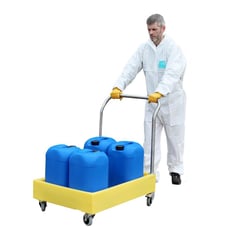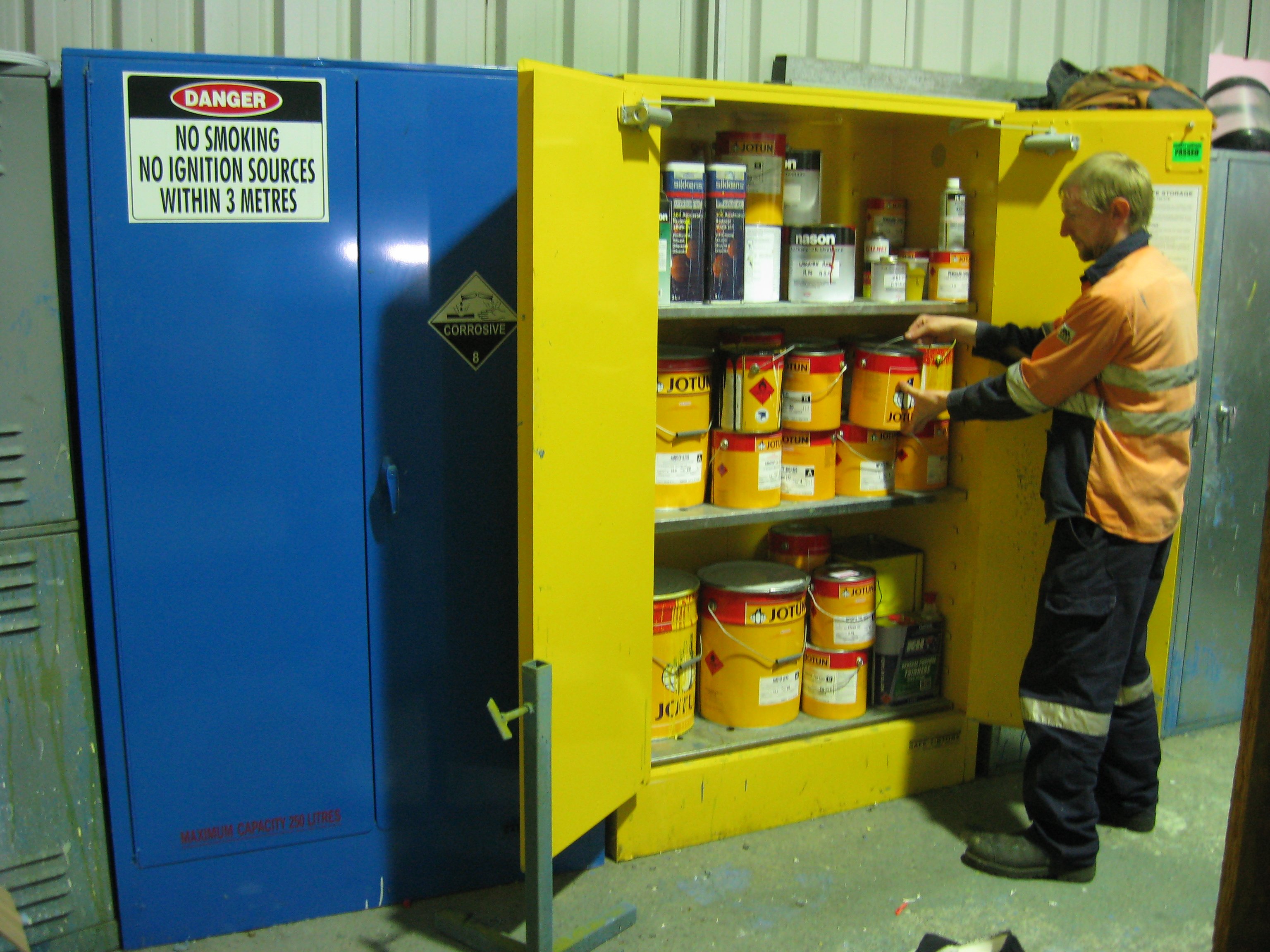Are your staff working with Class 3 Flammable Liquids and other Dangerous Goods? There are a complex range of hazards associated with the manual handling of chemical containers including lower back pain, neck injuries and joint problems. That’s in addition to the serious risks posed by handling flammable liquids. These include human harm due to the emission of hazardous vapours, as well as the risk of fires or explosions. In this blog, we’ll be detailing 5 important strategies to minimise manual handling and chemical exposure injuries in your workplace.
What Is The Manual Handling Of Flammable Liquids?
A significant amount of workplace injuries in Australia can be attributed to manual handling. Any type of physical or repetitive task can be classed as manual handling.
Some examples of common manual handling practices that are associated with flammable liquids in the workplace may include:
- Lifting (eg. drums, containers, decanting equipment)
- Pushing & Pulling (eg. moving trollies, drum dollies,
- Carrying (eg. flammable liquids containers, chemical packages)
- Holding (eg. transferring and decanting chemicals)
- Unpacking (eg. chemicals that have been delivered)
- Cleaning (eg. removing residue from containers or drums)
- Sorting (eg. stacking and loading flammable cabinets)
- Operating handling equipment (eg. using forklifts and other equipment)
While not all manual handling tasks are a hazard to workers, the more often the task is done and the greater the weight of the objects that need to be handled, the more risk there is to a worker.
Add to this the already hazardous nature of working with Dangerous Goods (with a range of risks including asphyxiation, burns and eye injuries — to name just a few), and you are faced with an array of serious hazards. If you are creating a safe and compliant working environment, you must address all of these manual handling and chemical hazards.
As with any Dangerous Goods area, we highly recommend conducting a risk assessment to determine the hazards in flammable liquids handling and storage areas. You may be able to identify hazards by walking through your business, speaking to staff and reviewing illness and injury records.
REMEMBER: Using the Hierarchy Of Controls, you should first attempt to eliminate the risk completely or substitute the chemical that you’re using. If that can’t be achieved, you should then look at engineering controls, administrative controls and PPE to control the risk.
What Ways Can You Improve Manual Handling Practices?
To help you reduce the risk that manual handling poses to your workers, we’ve highlighted 5 key steps that you can take to improve the health and safety of staff who handle Class 3 Flammable Liquids.
1. Use Lifting and Handling Aids
Poor lifting and carrying techniques can cause severe musculoskeletal injuries in any work situation. But when hazardous chemicals are involved, normal safe handling practices become even more complicated.

Utilise lifting and handling aids, such as a bunded trolley, to reduce the likelihood of a musculoskeletal injury or a flammable chemical spill.
To avoid contact with dangerous chemical residues, fumes and vapours, staff may use awkward movements and postures in their daily activities. There may also be an increased strain on the body due to staff being required to wear bulky and restrictive personal protective equipment (PPE).
Try these corrective actions for staff who are handling chemicals:
- Liaise with chemical suppliers and delivery companies to leave chemicals as close as possible to the chemical store.
- Use forklifts and pallet jacks to take chemical orders and deliveries directly to the flammable liquids cabinet.
- Fit chemical drums with spill lids and use drum dollies when moving single 205 litre drums around the worksite.
- Place smaller chemical containers on bunded trolleys for easy transfer.
- Use drum caddies for efficient transfer and chemical decanting.
REMEMBER: Where possible always use mechanical lifting and handling aids to reduce the stress and strain on your staff’s back, neck, limbs and joints.
2. Reduce Protective Clothing
As we’ve just touched on, staff who need to wear bulky PPE and protective clothing while lifting and carrying packaged flammable liquids may actually increase manual handling risk.
Some examples may include:
- Increased effort when wearing a full body suit, gloves, boots and mask — workers are vulnerable to heat stress.
- Minimised visibility wearing a chemical mask or eye shield when carrying packaged chemicals — workers are vulnerable to tripping or dropping the container.
- Bulky or ill-fitting gloves reducing grip — more likely for a worker to drop a container.
- Poorly fitted (or maintained) PPE — increased risk of chemical exposure injuries.
- Make sure PPE is individually fitted to each worker.
- Reduce distances between storage and transfer areas (where possible).
- Keep PPE clean, well maintained, and stored in dedicated PPE cabinets.
- Use elimination and isolation controls to reduce handling times and chemical contact points.
REMEMBER: It’s always best to find chemical hazard controls that reduce the need for PPE. When PPE makes manual tasks even more difficult, workers often will take shortcuts or won’t wear the PPE at all.
3. Train Workers In Proper Lifting and Carrying
Even with mechanical lifting aids in place, there will still be work areas and job tasks that require the physical handling of packages and containers. Make sure all relevant staff and external contractors are trained in proper manual handling techniques.

To reduce the risk of injury, ensure that all staff handling Dangerous Goods are educated in the correct manual handling procedures.
As a minimum, you should also have specific handling procedures in place for:
- Unloading containers from pallets and carrying them to the chemical store.
- Moving 205 litres drums.
- Mixing cleaning chemicals.
- Decanting fuel and carrying back to a work station.
- Teach workers how to lift with a straight back, bending the knees.
- Make sure staff keep the packages close to the body, lifting with their thigh muscles, to reduce strain.
- Ensure workers don’t attempt to carry loads that are too heavy.
- Stabilise loads with stretch wrap, straps, or bands.
- Organise the work areas to minimise the amount of movement required by workers.
- Encourage staff to take breaks to rest their body.
- Teach staff to warm up by stretching before attempting manual handling.
- Implement good work design so workers don’t have to lean or bend over to access chemicals.
- Prohibit manual handling of chemical containers above head height.
IMPORTANT: A worker who trips while carrying a container of flammable liquids creates an immediate risk of chemical spill, fire, explosion and exposure hazard — as well as a likely musculoskeletal injury.
4. Implement Good Housekeeping
Housekeeping can play an important role in reducing manual handling incidents and chemical exposure injuries. Crowded work areas and blocked throughways reduce access for forklifts and handling aids — as well as increase the risk of staff tripping or falling.
Try these corrective actions for staff who are at risk of chemical exposure:
- Clear space at the loading dock and chemical storage areas to allow forklift access.
- Keep throughways clear of pallets and debris.
- Put chemical orders away immediately on delivery.
- Use general purpose cabinets and racking systems for non-hazardous materials to reduce clutter.
- Allow plenty of space in chemical stores to prevent excessive loading and unsafe stacks.
- Use indoor flammable liquids cabinets that have heavy duty shelving and self-closing doors.
- Store heavier items between knee and shoulder height to reduce strain on the body.
5. Control The Purchasing Of Chemicals
Manual handling incidents can also be minimised by reducing the range of chemicals held onsite — and avoiding overstocking. Work with chemical supply companies so you can order less chemicals, but more often.

By managing your flammable liquid supplies more effectively, and reducing the amount of stock you carry, your workplace can minimise the risk of manual handling injuries.
Try these corrective actions for staff who are managing chemical supplies:
- Reduce the size and weight of chemical containers.
- Change the shape of chemical containers to improve grip.
- Look for safer alternatives and multi-use products that allow you to reduce the chemical range.
- Liaise with chemical suppliers to limit the use of packaging that requires cutting or significant force to release the containers.
- Implement a closed chemical decanting facility.
REMEMBER: Ordering chemicals in containers that are easy to open reduces the likelihood of workers using an inappropriate object, such as a screwdriver or a clawhammer, to open the container.
Are Your Staff Manually Handling Dangerous Goods?
Whether your staff are loading, unloading, transferring, handling or decanting flammable liquids (and other hazardous chemicals), make sure you’re aware of how you can reduce the risk of injuries at your workplace. One important step in achieving safe chemical handling and storage is to ensure that your flammables are kept in a Class 3 Flammable Liquids Cabinet. This will not only make the workplace more organised and efficient, it also allows staff to have a safe and dedicated space to securely store chemical containers and drums after they’ve been used. This reduces the risk of manual handling injuries, as well as minimising the likelihood and impact of chemical spills, uncontained hazardous vapours, violent chemical reactions with incompatible substances and flammable liquids igniting due to poor storage practices.
To learn more about how to minimise the risks associated with flammable liquids in the workplace, why not access our informative eBook Essential Considerations When Storing Flammable Liquids Indoors? It’s completely free and available for download now.
Joining the team as a Dangerous Goods Storage Consultant, Melissa Hampton became Storemasta's Marketing Manager in late 2021. With extensive knowledge and experience in chemical compliance, Melissa is responsible for leading the Marketing team and helping shape their marketing strategy. In her spare time, you can find Melissa hiking, swimming and enjoying the great outdoors in beautiful north-west Tasmania.
